Luận án Utilization of cassava forages for goat production in An Giang province, Vietnam
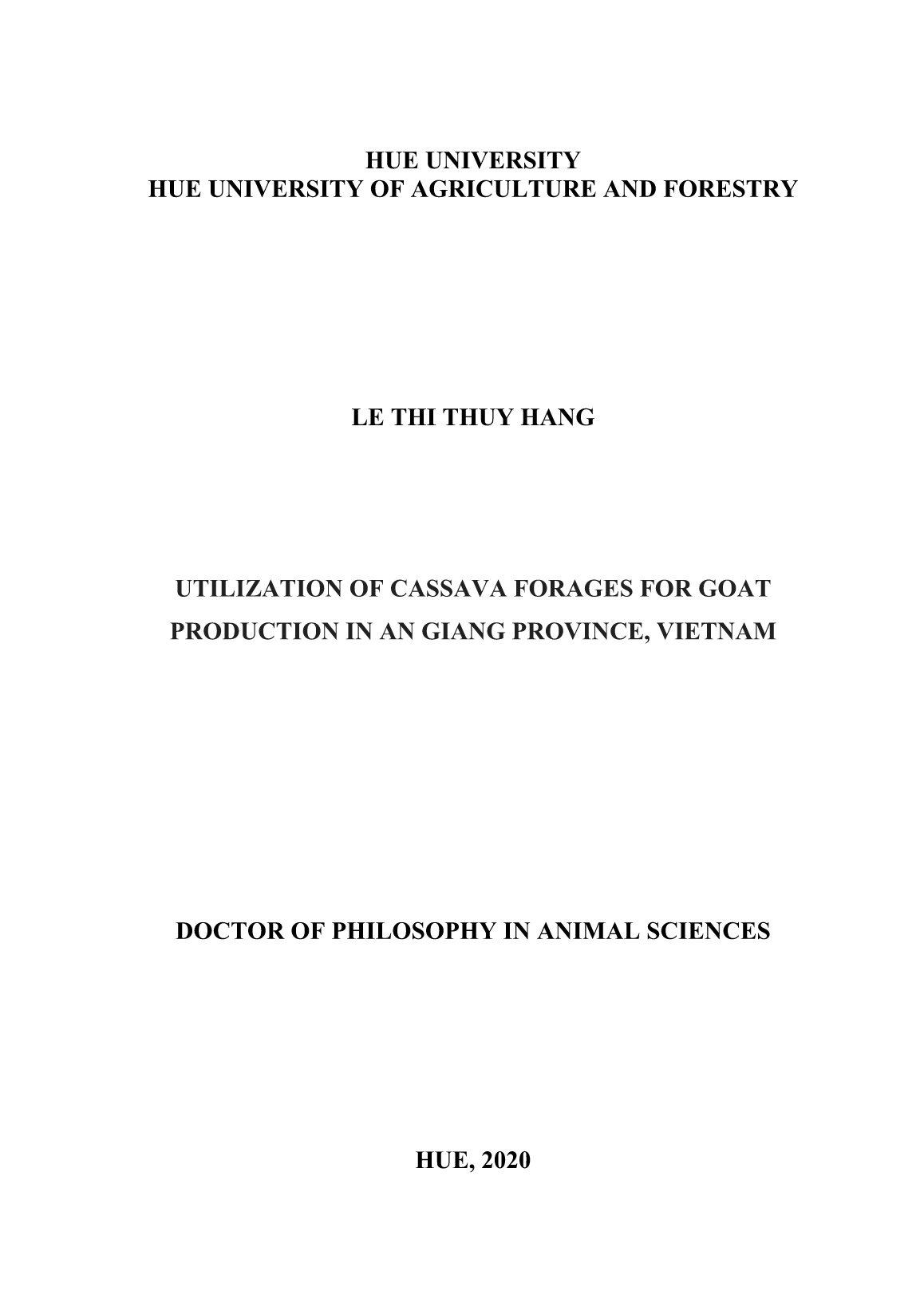
Trang 1
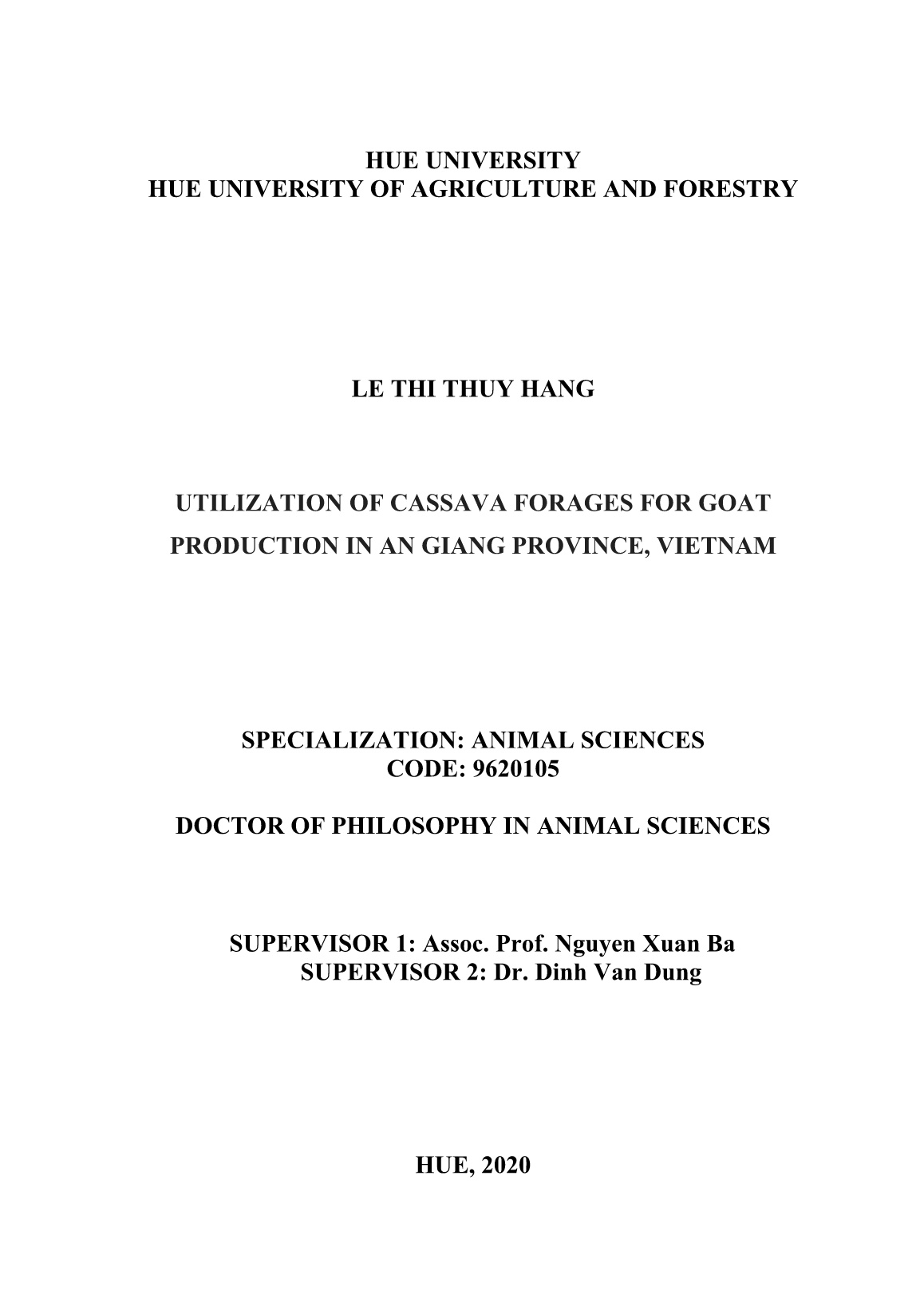
Trang 2
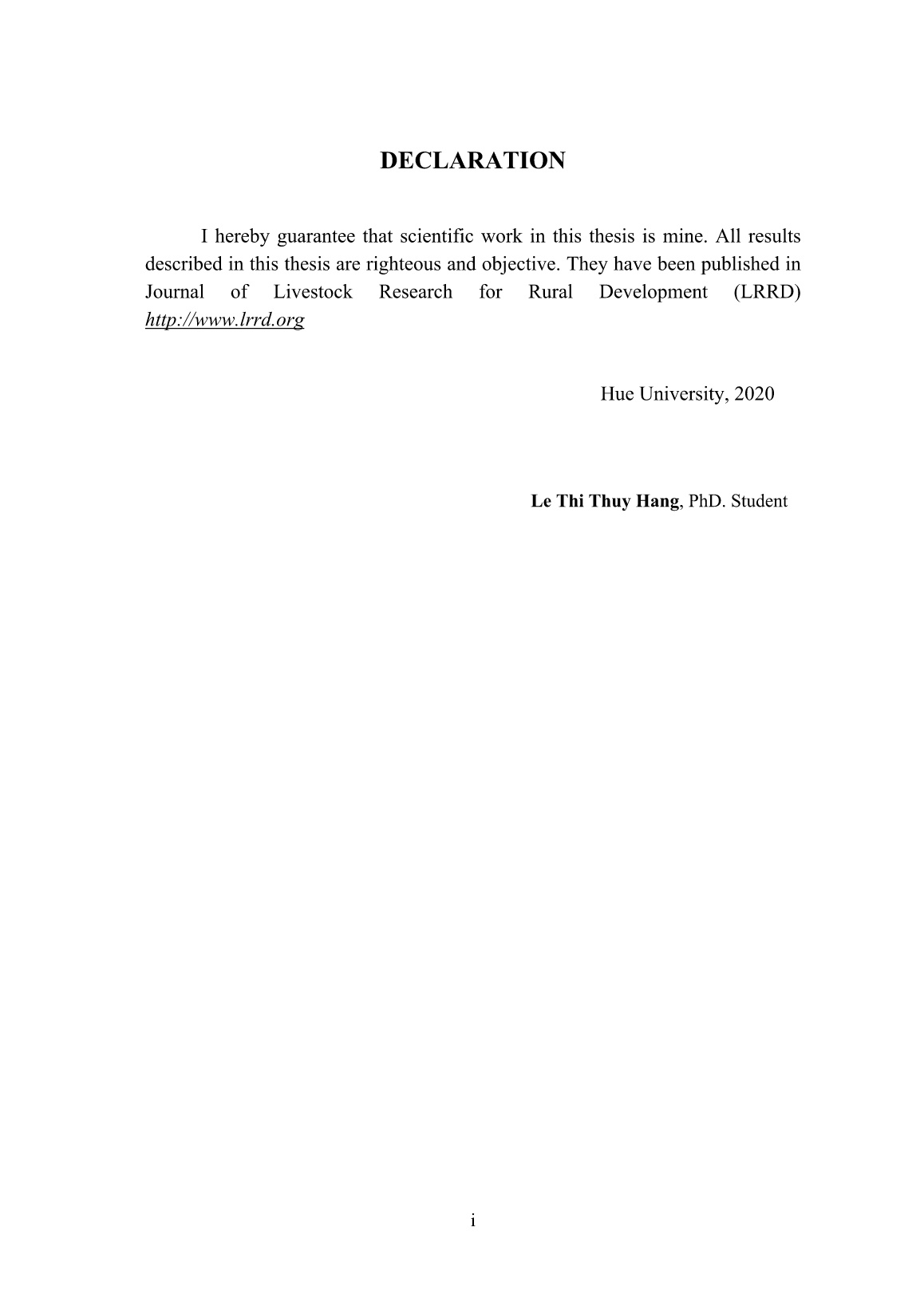
Trang 3

Trang 4

Trang 5
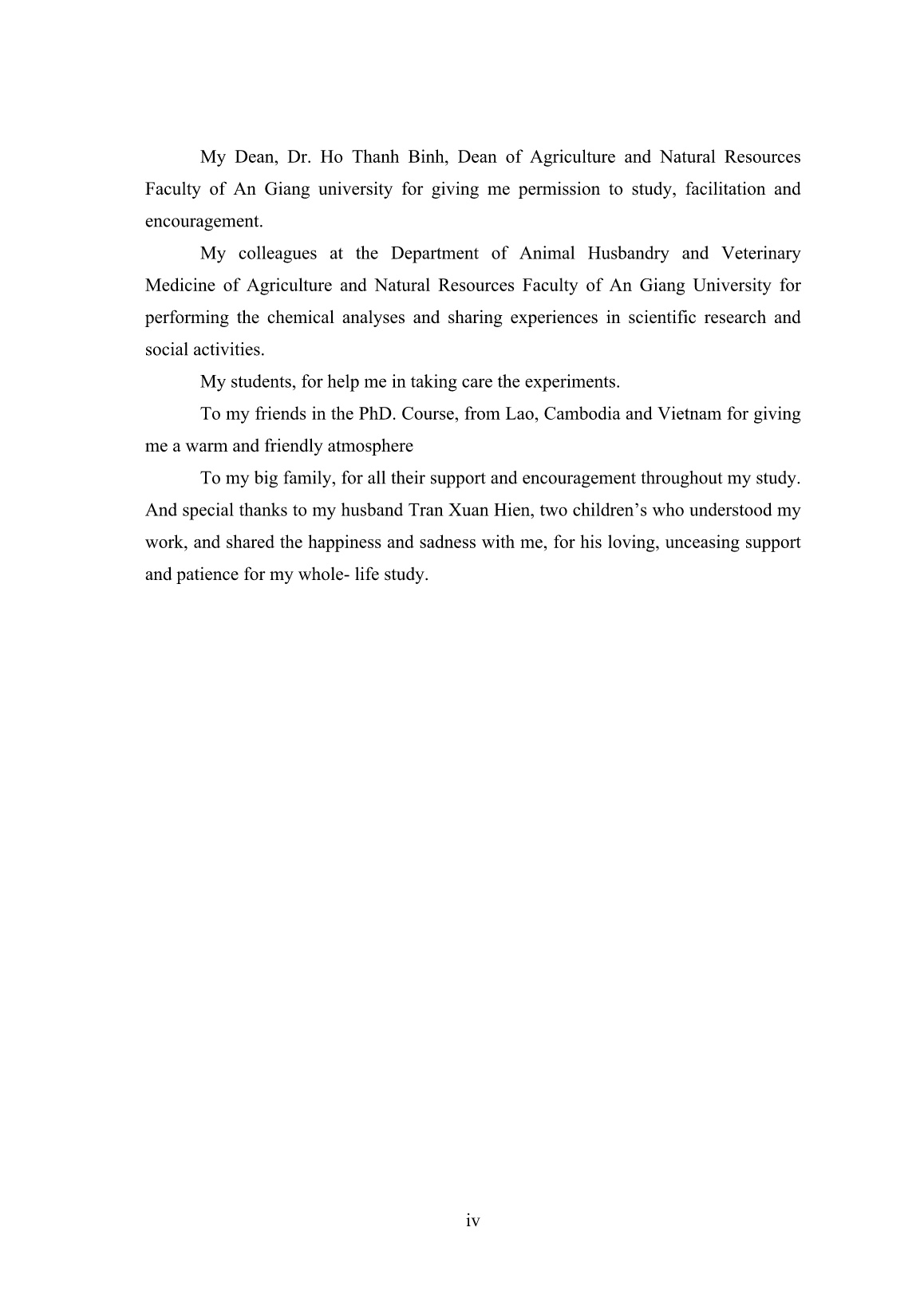
Trang 6
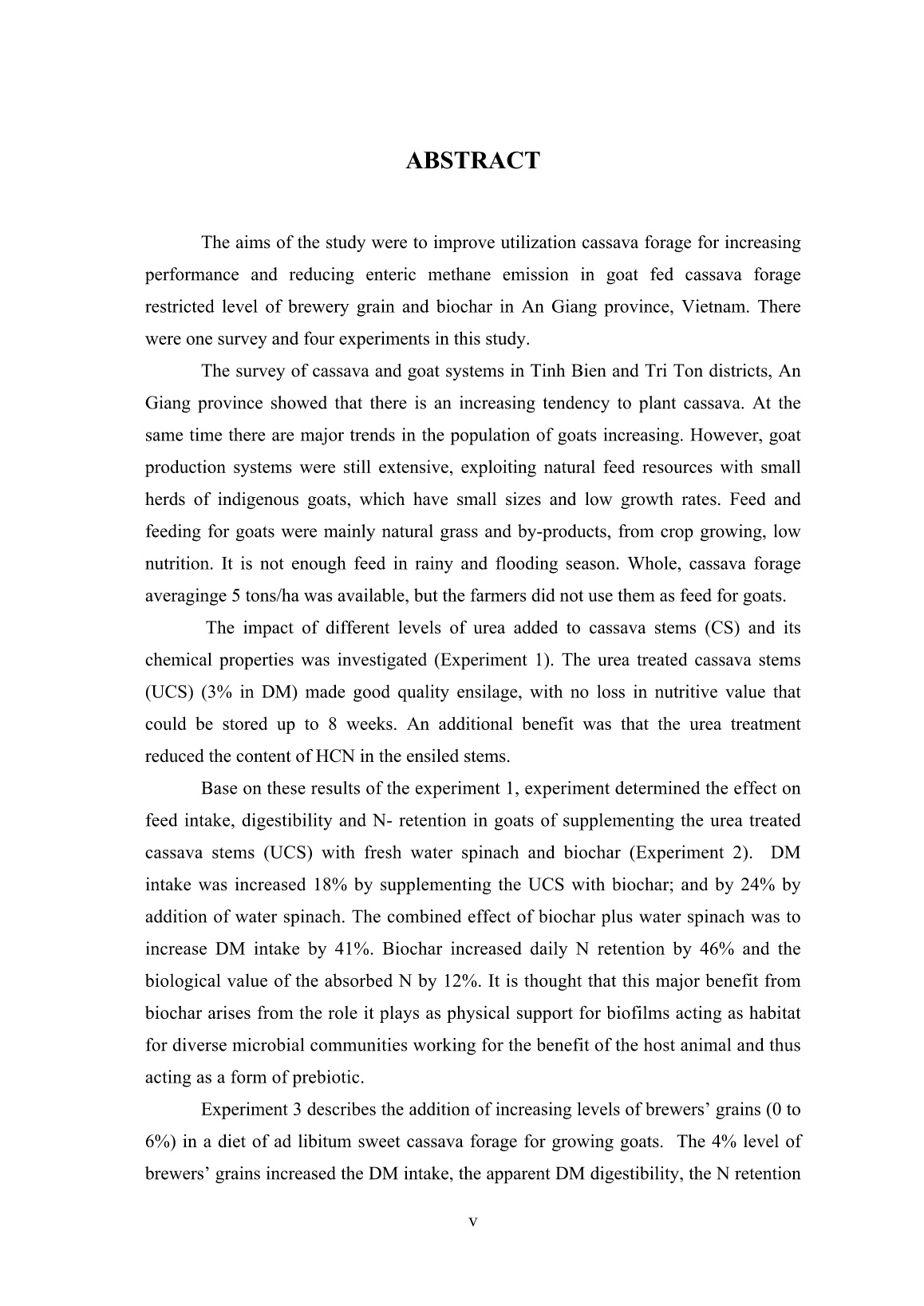
Trang 7
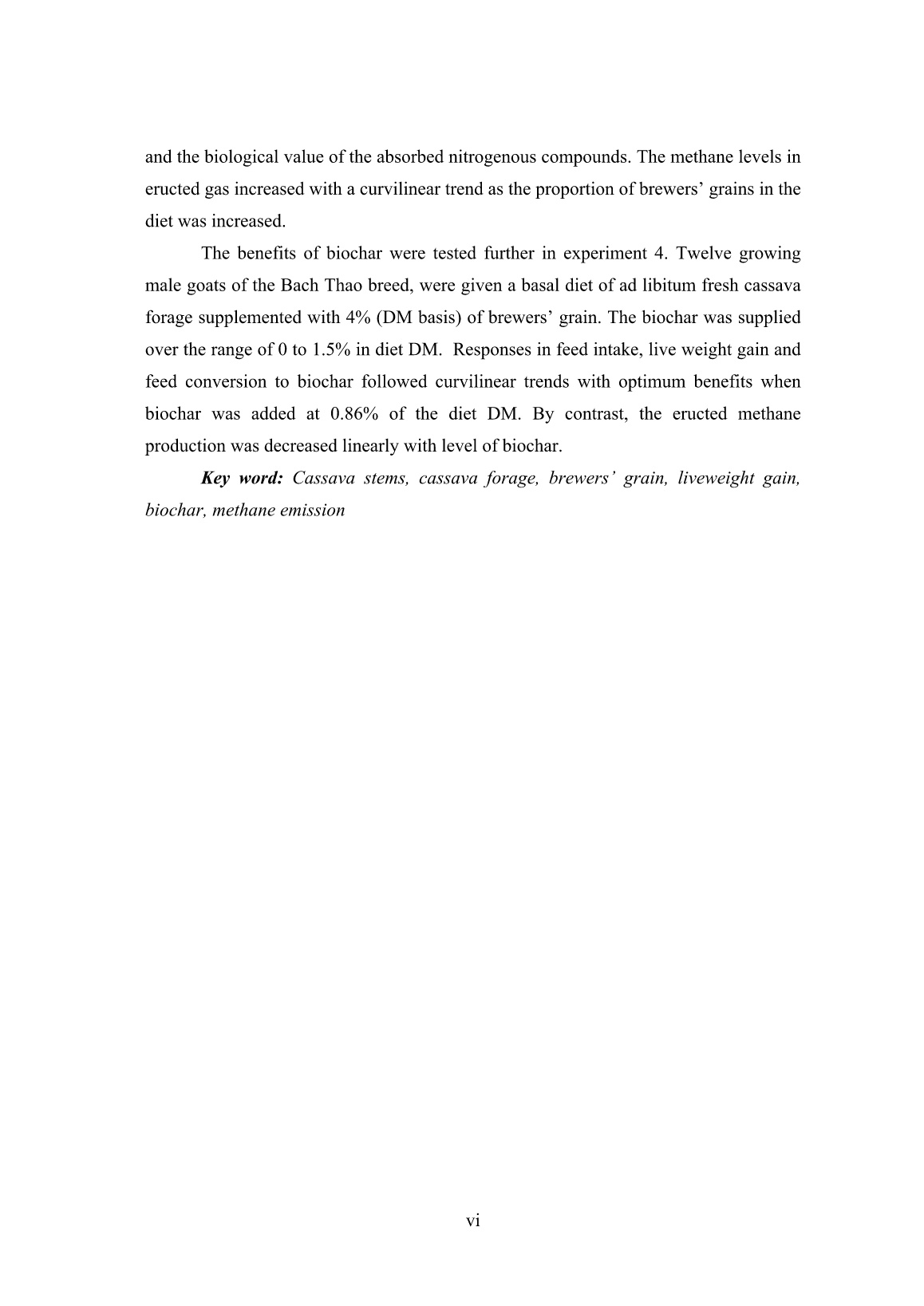
Trang 8
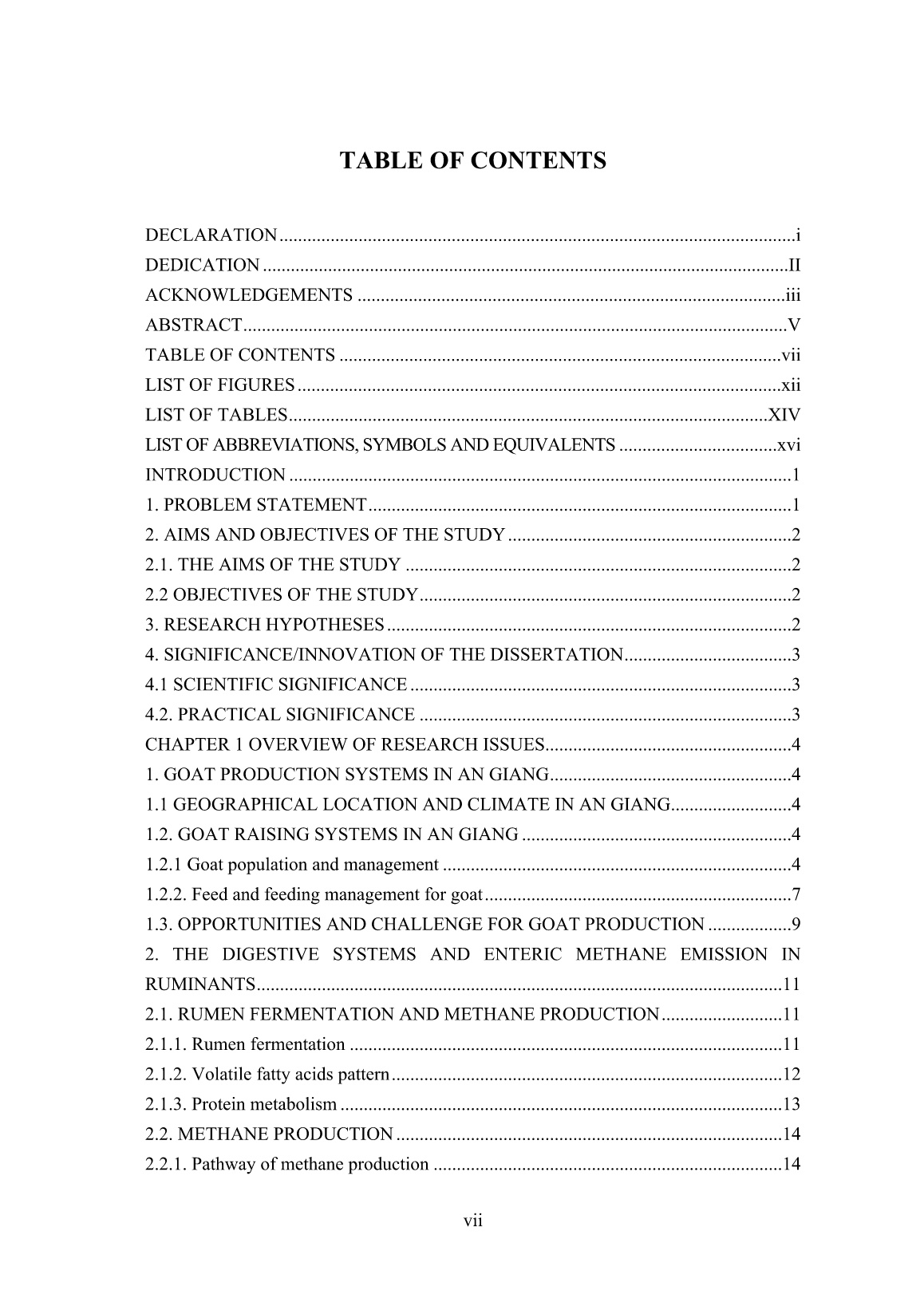
Trang 9
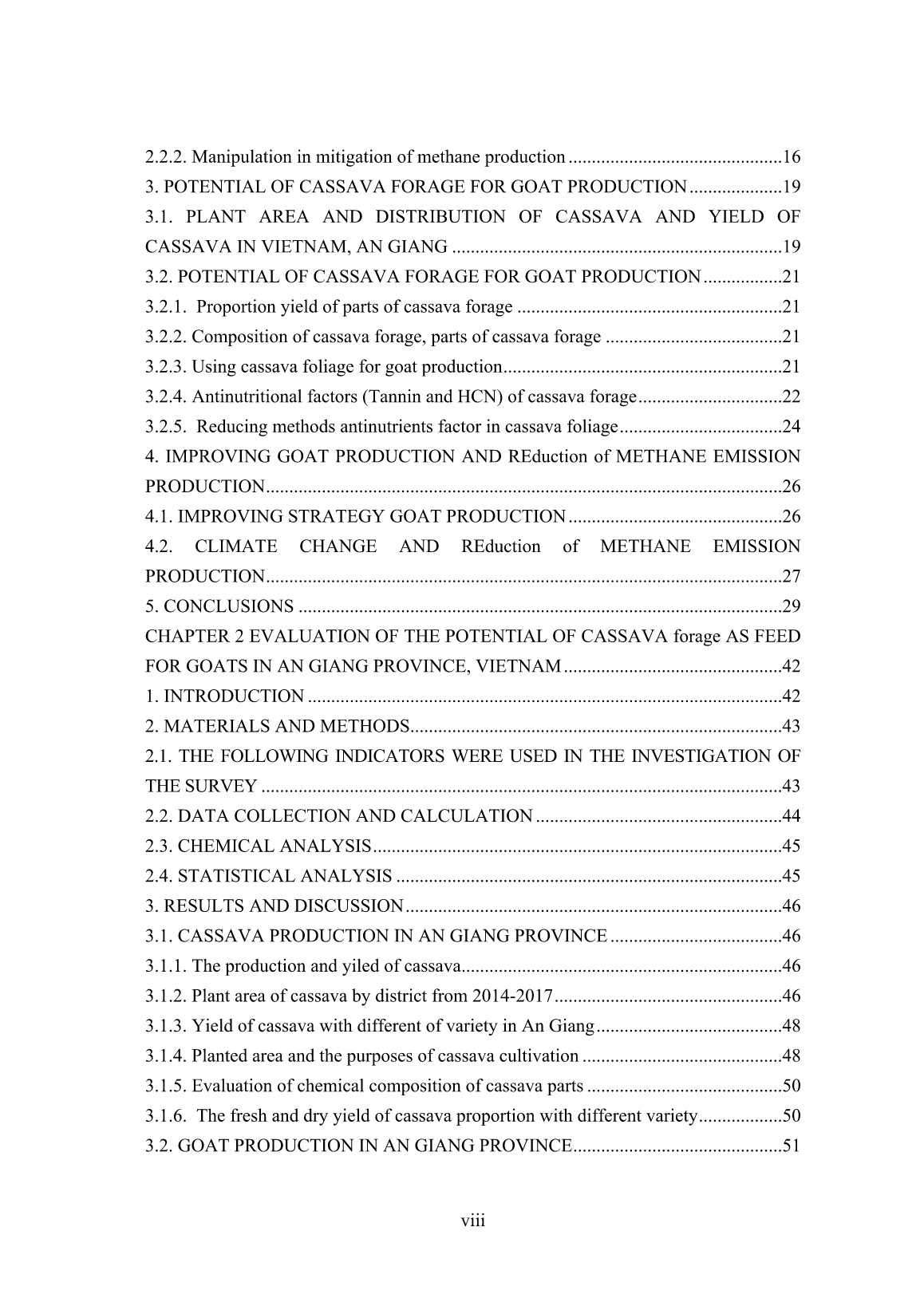
Trang 10
Tải về để xem bản đầy đủ
Bạn đang xem 10 trang mẫu của tài liệu "Luận án Utilization of cassava forages for goat production in An Giang province, Vietnam", để tải tài liệu gốc về máy hãy click vào nút Download ở trên.
Tóm tắt nội dung tài liệu: Luận án Utilization of cassava forages for goat production in An Giang province, Vietnam
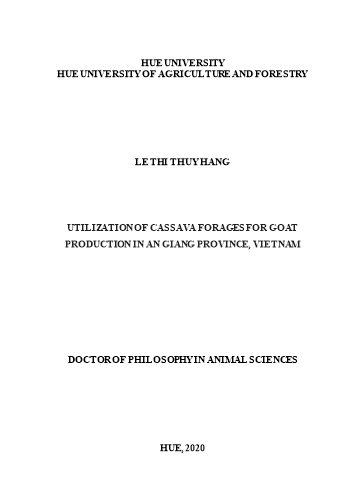
eld in the present study ranged from 0.53 to 0.83 tonnes ha-1 about 11 months of growth. The differences in results are probably due to the differences in the variety, soil fertility, harvesting time, climate (Moore, 1976; Khang et al., 2004). 3.1.6. The fresh and dry yield of cassava proportion with different variety In the present study, after root harvesting, there was cassava plant remains. Cassava plants were divided into two parts: hard stems (one third above the soil of cassava plant) and cassava forages (two third of aerial part of cassava plant). It was described in Figure 2.1 & 2.2). The fresh and dry weight proportion of cassava plant is shown in table 2.6. The cassava forage was differences between two varieties of cassava. The proportion of sweet cassava forage was higher than the bitter cassava. The reason is that the harvesting time of bitter cassava was a long time after planting (10 – 12 months) while, the harvesting time of sweet cassava was 6-8 months, the plant has more leaves, shorter and softer stems. The mean dry leaf proportion of sweet cassava forage was high (51.7%) similar to an earlier study by Meyrelles et al. (1977), the leaf propostion of cassava forage on DM basic was almost 52%, but it was slightly lower than found in study result of Khang et al. (2004) (59%). These results were different due to the differences in variety, farming conditions, regions, soil, and fertilization and cutting time. Table 2.6: Yield of cassava proportion with different variety Sweet cassava (tons/ha) Proportion % Bitter cassava (tons/ha) Proportion % Fresh cassava plant Hard stems 13.2 ± 3.6 33.5 17.2 ± 4.5 54.0 Cassava forage 26.2 ± 7.2 66.5 14.7 ± 3.8 46.1 Cassava stems 8.7 ± 2.4 22.1 4.9 ± 1.3 15.3 Leaves + petiole 17.5 ± 4.8 44.4 9.8 ± 2.5 30.7 DM cassava plant Hard stems 5.5 ± 1.5 49.1 6.4 ± 1.6 62.1 Cassava forage 5.7 ± 1.6 50.9 3.9 ±1.0 37.9 Cassava stems 2.1 ± 0.5 18.4 1.2 ± 0.3 11.3 Leaves + petiole 3.6 ± 1.0 32.5 2.7 ± 0.76 26.6 CP of cassava forage in DM (tons/ha) 0.79 ± 0.23 - 0.52 ± 0.15 - 3.2. GOAT PRODUCTION IN AN GIANG PROVINCE 3.2.1. Ruminants population in An Giang from 2014- 2017 Goat production in An Giang increased 3.2 times from 2014 to 2017. The reasons for this increase were that goat are easy to raise, are a low investment, there is an increasing price and increasing consumption of goat meat, in not only An Giang but also in the whole country. Table 2.7. Population of ruminants in An Giang from 2014- 2017 Unit: heads Ruminants Year 2014 2015 2016 2017 Goat 4,325 7,876 11,905 13,950 Cattle 109,306 111,709 96,040 81,543 Buffalo 4,181 4,013 3,876 3,265 Source: Statistical yearbook of An Giang 2018 In recent years, goat production in An Giang is shown in table 2.7. Based on the survey, the climate, weather and natural conditions were suitable for developing goat raising. The total area of hilly land in An Giang is about 29,320 ha, accounting for 8.6% of the total land area of the province. There are natural grass and agricultural by-products all year round, there is a clean water source, farmers love raising and goat raising, therefore, goats were raised a long time ago in An Giang. However, goat raising is still not much developed, because goats were raised by traditional farming, farmers did not utilize by-product efficiency. Goats were raised and concentrated in the Phu Tan - Tan Chau districts to the mountainous areas of Tri Ton and Tinh Bien. Currently, the goat production in 2017 was 13,950, the most was in Tinh Bien (2,428); Tri Ton (2,245) (Statistical An Giang yearbook, 2018). The number of goats in 2017 increased by 3.2 times compared to 2014, because the price of goats in the market increased sharply, while households with more than 20 heads / household accounted for 49.2%. 3.2.2. Goat farm size and purpose raising in An Giang province Base on the survey results, the farm size and structure of goats in the Tinh Bien and Tri Ton districts are presented in table 2.8. The goat farm size were divided into three groups: the group of raising households below 10 accounts for the lowest percentage, the number of households raising over 20 heads accounts for a high percentage (59%), this result was higher than the research results of Nguyen Binh Truong (2016) goats raised in Tinh Bien district were 26.7% with households raising more than 20 heads per household. Thus, Goat breeding in An Giang, especially Tinh Bien area developed and increased clearly. Table 2.8. Farm size and purpose raising Items Tri Ton Tinh Bien Total percentage % Number percentage % Number percentage % Farm size (Household) 1-<10 heads/farm 14 23.3 5 8.3 19 15.8 10-20 heads/farm 27 45 15 25 42 35.0 > 20 head/farm 19 31.7 40 66.7 59 49.2 Purpose raising (Heads) Meat 691 62.9 1,163 95.1 1,854 79.8 Breeding 408 37.1 60 4.9 468 20.2 Total 1,099 1,223 The purpose of raising goats here was mainly to sell meat at 79.8%, in addition to raising goats with the purpose of selecting good ones in the herd to sell goats for local market, or neighbourhood; but account for a smaller percentage (20.6%). In addition, markets for goat production (eg: milk, cheese, ...) are in the cities providing farmers with better income and opportunities for further development (Nguyen Van Thu, 2016). There is a high demand for goat meat in many different areas of Vietnam from the North to the South and the rate of increase in the number of goats annually is not sufficient to meet the demand. Therefore, many farmers and companies are preparing to build large commercial farms with the importation of dairy goat breeds for both milk and meat. 3.2.3. Goat prodution systems in An Giang The results in Table 2.9 showed that goats were raised intensive, semi- intensive and extensive systems and intensive was highest (55%). Table 2.9. Goat production systems in Tri Ton and Tinh Bien district Number of farms in district Total Percentage, % Management Tri Ton Percentage, % Tinh Bien Percentage, % Intensive 31 51.7 35 58.3 66 55.0 Semi-intensive 27 45.0 25 41.7 52 43.3 Extensive 2 3.33 0 0.00 2 1.67 Intensive systems are the main method of goat raising in An Giang, this result was similar to the results of Nguyen Binh Truong (2016) who found raising goats by intensive systems was 66.7%. This systems of complete confinement helps the farmers manage each individual, can detect disease or manage oestrus in a timely manner, but feed had to controled actively, while semi- intensive systems help goats have time to graze, develop the right features and reduce the reserve of food. According to the study of Bounmy and Nguyen Xuan Trach (2010) in Laos, semi-grazing is the most common farming method, accounting for 100% of the surveyed households. By- products, storage or processing of goat feed reserves have not been considered. Goat grazing is restricted in farming areas because goats are destructive, eating a variety of foods affecting other households' crops. Although raising by completely captive raising methods, the farmers in the surveyed areas still raise their livestock in the traditional way, around the farming area, there were any kind of edible plants that can be used, not interested in the demand. Nutrition for goats, how to coordinate, reserve feed sources for goats to ensure nutritional needs according to each stage of their development are not of interest in this system. In addition, extensive farm is causing increase green house gas (GHG) emissions as Alexandra and Irene (2015) reported that GHG emissions were particularly high in the extensive farm, because of its low productivity and the excessive use of pastures in livestock feeding. Therefore, intensive systems can manage feed and limite methane emissions from ruminants. 3.2.4. Feed and feeding systems Goat feed is very diverse in Tinh Bien and Tri Ton district, beside natural grass, there are many kind of leaves, eg: jackfruit leaves, magic vegetables, banana leaves, peanuts, and sweet potatoes, but limited in quantity. In the survey area, the main feed is natural grass, 100% of the households use natural grass and a source of locally available by-products except cassava leaves. Few households (21.7%) among surveyed households grew grasses: elephant grass, VA06 grass to supplement feed in the dry or flooding season or at harvest time. In addition to the main feed source of natural grass and seasonal byproducts, a few households had supplied salt (38.3%), rice bran (18.3%); very few households used concentrate supplement, all fewer households (35%) did not supply supplements. The farmers did not care about quaities or chemical composition of grass or by-product, so they did not supply enough nutrition for their goats, especially in the dry season (from February to May). The results were slowly growth rate, and low production. Beside that, the nutritional supplement, especially protein sources, mineral, visibly improve productivity of goats (Phengsavanh, 2003; Keopaseuht et al., 2004; Bounmy Phiovankham and Nguyen Xuan Trach, 2011). Table 2.10. Feed and feeding systems for goats in Tri Ton and Tinh Bien district Tri Ton Tinh Bien Items Household percentage, % Household percentage, % Feed Natural grass 60 100 60 100 Natural grass + Leaves (except CL) 9 15 4 6.67 Natural grass + by-products 28 46.7 36 60 Natural grass + cassava forage 4 6.67 2 3.33 Natural grass + Grass growing 13 21.7 13 21.7 Natural grass + Commercial concentrate 6 10 5 8.33 Supplements Salt 15 25.0 23 38.3 Rice bran 9 15.0 11 18.3 Commercial Concentrate 5 8.3 5 8.33 No supplement 31 51.7 21 35.0 Note: CL: cassava leaves 3.2.5. Diseases and diseases management The survey results of 60 households raising goats in 2 districts (Table 2.11) show that 50.8% of total households have never used vaccines for goats. The most common disease for goats was often diarrhea (26.9%), other disease eg: coughing, sneezing and rumen bloating, accounting for 23.4%. Although there are veterinary facilities in the communes of the two districts surveyed for animals welfare, the farmers used less vaccine to prevent diseases. Farmers often bought drugs for injection those diseases such as diarrhea, fever and cough. In recent years, there have been occasional illnesses such as mouth ulcers. People often used traditional method such as finding some leaves to apply to ulcers. For other diseases such as rumen bloating, and mastitis most farmers have not found any cure for goats. This is causing low goat production. Table 2.11. Diseases and diseases management of goats Diseases and management Tri Ton Tịnh Bien Total Percentage, % Household percentage, % Household percentage, % Diseases Parasites 4 4.9 5 5.6 9 5.3 Mouth ulcer 15 18.3 13 14.6 28 16.4 Diarrhea 25 30.5 21 23.6 46 26.9 Infectious diseases 15 18.3 14 15.7 29 17 Difficult birth 5 6.1 14 15.7 19 11.1 Others (cough, Sneeze, rumen bloating;,...) 18 22 22 24.7 40 23.4 Diseases management Vaccine 17 28.3 28 46.7 45 37.5 No vaccine 37 61.7 24 40.0 61 50.8 Deworming 6 10.0 8 13.3 14 11.7 4. CONCLUSIONS In An Giang province, goat production is developing with promising conditions of abundant feed resources, good government policies, improved research results, good markets and efficient development strategies. However, some constrains for production development such as low breed quality, lack of large farms and improving nutrient of feed, limited knowledge, poor marketing and less international co-operation should be improved for a sustainable goat production and dairy goat production also. Beside that, cassava forage has potential in An Giang. The average of dry matter cassava forages was 5 ton/ha in 2017. They can be used as a protein source, as a replacement for grass for ruminants but farmers did not use because it is high HCN content. How to use and preserve cassava (including the stems) as feed ruminants and against toxicosis by reducing HCN content. The other thing, after a few days root harvesting, leaves will fall down, cassava stems were only remaining. Based on that situation, the study of utilizing is not only cassava forage, but also cassava stems necessary and practically by alkaline method. Therefore, the interest in using urea treated cassava stems could be improved with improved nutritive value and preservation. REFERENCES Alan J.D. and John A.M., 1993. Effect of oral administration of brassica secondary metabolites allyl cyanide, allyl isothocyanate and dimethyl disulphide, on the voluntary food intake and metabolism of sheep. British Journal of Nutrition 70, 631-645 Alexandra S. and Irene T., 2015. Greenhouse gas emissions in dairy goat farming systems: Abatement potential and cost. AOAC, 1990. Official Methods of Analysis. 15th Ed. Association of Official Analytical Chemists, Washington DC. AOAC, 2016. Official Methods of Analysis, 20th Edition. Association of Official Analytical Chemists, Washington D.C. Bounmy Phiovankham and Nguyễn Xuân Trạch, 2011. Current Status of Goat Production in Laos. Journal Sicences and Developing 2011. Volume 9 (3). P 364-370. Ha Noi University of Agriculture. Cooke R. D., 1983. Effects of cassava processing on residual cyanide. In Delange, E, and Ahluwalia, R. (eds.), Cassava Toxicity and Thyroid: Research and Public Health Issues, Proceedings of a workshop held in Ottawa, Canada, 31 May-2 June 1982, IRDC-207e, Ottawa, pp. 138-142. Dufour D. L., 1988a. Cyanide content of cassava (Manihot esculenta, Euphorbiaceae) cultivars used by Tukanoan Indians in Northwest Amazonia. Economic Botany 42(2): 255-266. Duong Nguyen Khang, Hans Wiktorsson and Thomas R. Preston, 2005. Yield and Chemical Composition of Cassava Forage and Tuber Yield as Influenced by Harvesting Height and Cutting Interval. Asian-Australasian Journal Animal Science. 2005. Vol 18, No. 7 :1029-1035 Hong N. T. T.,. Wanapat M, Wachirapakorn C., Pakdee P. and Rowlinson P., 2003. Effects of timing of initial cutting and subsequent cutting on yields and chemical compositions of cassava hay and its supplementation on lactating dairy cows. Asian-Australasian Journal Animal Science. 16:1763-1769 Keopaseuht T., Ty C., Bounthong B., Preston T. R., 2004. Effect of method of offering forages of Gliricida sepium and Stylosanthes guianensis CIAT 184 (Stylo) to goats on intake and digestibility. Livestock Research for Rural Development 16. Khang D. N. and Wiktorsson H., 2000. Effects of cassava leaf meal on the rumen environment of local yellow cattle fed ureatreated paddy straw. Asian-Australian Journal Animal Sciences. 13:1102-1108. Khang D.N. and Wiktorsson H., 2004. Effects of fresh cassava top on rumen environment parameters, thyroid gland hormones and liver exzymes of local yellow cattle fed urea treated fresh rice straw. Tropical Animal and production, 36(8), 751-762. Le Van Khoa and Nguyen Thị Thuy Dương, 2012. Hiện trạng canh tác và tiềm năng sản xuất vùng đất phong hóa tại chỗ huyện tri tôn, tỉnh An Giang. (Current status of cultivation and potential production of weathered land in Tri Ton district, An Giang province). Volume 21b p.78-86. Can Tho Univeristy. Lockard R. G., Saqui M. A. and Wounuah D. D., 1985. Effects of time and frequency of leaf harvest on growth and yield of cassava (Manihot esculenta Crants) in Liberia. Field Crops Res. 12:175-180. Man N. V. and Wiktorsson H., 2001. Cassava tops ensiled with or without molasses as additive effects on quality, feed intake and digestibility by heifers. Asian-Aust. J. Anim. Sci. 14:624-630 Mckey D., Cavagnaro T. R., Cliff J.and Gleadow R., 2010. Chemical ecology in coupled human and natural systems: people, manioc, multitrophic interactions and global change. Chemoecology, v. 20, n. 2, p. 109-133. Meyrelles L., MacLeod N. A. and Preston T. R., 1977. Cassava forage as a source of protein: effect of population density and age of cutting. Tropical Animal Production 2:18-26. Molina J. L. and El-Sharkawy M. A., 1995. Increasing crop production in cassava by fertilizing production of planting material. Field Crops Res. 44:151-157 Moore C.P., 1976. The utilization of cassava forage in ruminant feeding. Proceeding of the International symposium “Tropical Livestock production”, Acapulco, Mexico, 21. Mui N.T.,1994. Economic evaluation of growing Elephant grass, Guinea grass, Sugarcane and Cassava as animal feed or as cash crops on Bavi high land. In: Proceeding on Sustainable Livestock Production on Local Feed Resources. Agricultural Publishing House, 16-19 Nguyen Binh Trương, 2016. Khảo sát thành phần dinh dưỡng trong thức ăn của dê thịt ở an giang (Survey nutrient content in goat meat in An Giang). Science and Technology Research of An Giang University. Nguyen Van Thu, 2016. Recent Research and Development of Dairy Goat Production in Vietnam. In proceedings of 3rd Asian- Australasian Dairy Goat Conference. China. Pp.129-139 Nguyen Xuan Trach and Buonmy Phiovankham, 2011. Determination of growth functions of indigenous and crossbred goats in Laos. Journal of Southern Agriculture (China) 42 (1): 82-85 Phengsavanh P., 2003. Goat production in smallholder farming systems in Lao PDR and the possibility of improving the diet quality by using Stylosanthes guianensis CIAT 184 and Andropogon gayanus cv Kent. MSc.Thesis. Swedish University of Agricultural Sciences, Uppsala, Sweden. Phengvichith V. and Ledin I., 2007. Effect of feeding different levels of wilted cassava forage (Manihot esculenta, Crantz) on the performance of growing goats. Small Ruminant Research 71(1-3), 109-116. Tung C. M., Liang J. B., Tan S. L., Ong H. K. and Jelan Z. A., 2001. Forage productivity and growth persistency of three local cassava varieties. Asian-Australasian Journal Animal Science .14:1253- 1259 Wanapat M., 2001. Role of cassava hay as animal feed in the tropics. Preston, T.R. et al. (Eds.). In: Proceeding of the International Workshop on Current Research and Development on Use Cassava as Animal Feed. Khon Kean University, Thailand Wanapat M., Pimpa O., Petlum A. and Boontao U., 1997. Cassava hay: A new strategic feed for ruminants during the dry season. Livestock Research for Rural Development 9 (2), 1-5. Wilson W.M. and Dufour D.L., 2002. Why “bitter” cassava? The productivity of “bitter” and “sweet” cassava in a Tukanoan Indian settlement in the Northwest Amazon. Economic Botany 56(1): 49-57. CHAPTER 3 USING UREA TO TREAT CASSAVA STEMS AND EFFECT OF WATER SPINACH AND BIOCHAR ON FEED INTAKE, DIGESTIBILITY AND N-RETENTION IN GOATS FED UREA TREATED CASSAVA STEMS Abstract The specific objectives were to determine what level of urea treated cassava stems would facilitate the storage, improving nutritive value and the same time improve its digestibility. Then, determining the synergistic effect of biochar and water spinach on growth of goats fed urea treated cassava stems. There were two experiments: Treated cassava stems with 5 levels of uera (0; 1; 2; 3; 4 % in DM) as treatments and 4 replications. All treatments were kept in anaerobic conditions. Treated cassava stems appearance characteristics were observed, pH value, HCN, tannin content and chemical composition were measured at the storage times (0; 2; 4; 6 and 8 weeks). The results were that with 8 weeks storage, urea treated cassava stems were preserved of high quality in the evaluation of color, ammonia, mold appearance, and pH. Cassava stems treated with 3% urea level in DM had improved nutrient value. Urea treatment of the cassava stems increased the crude protein from 5.5 to 11.7% in DM and urea treatments were effective in delignifying HCN content of cassava stems. Moreover, this level of urea is needed to prevent mould in cassava stems ensiled with urea. The 3 % level of urea in DM was the best treatment and chosen for the next experiment. Four “Bach Thao” goats (LW 14 ± 2 kg) were fed urea-treated cassava stems alone (UCS) or with a supple
File đính kèm:
 luan_an_utilization_of_cassava_forages_for_goat_production_i.docx
luan_an_utilization_of_cassava_forages_for_goat_production_i.docx 2. Full papers published.pdf
2. Full papers published.pdf 2. List of published scientific papers.docx
2. List of published scientific papers.docx 3. Summary of thesis.docx
3. Summary of thesis.docx 3. Summary tiếng việt.docx
3. Summary tiếng việt.docx 4. Abstract - Tóm lược.docx
4. Abstract - Tóm lược.docx 5. EXPLANATION OF REVISING DISSERTATION.docx
5. EXPLANATION OF REVISING DISSERTATION.docx 6. Declarecation.docx
6. Declarecation.docx 7. THE NEW CONTRIBUTION OF THE DISSERTATION.docx
7. THE NEW CONTRIBUTION OF THE DISSERTATION.docx 9. DECLARATION TO CONFIRM THE DATA IN CD.docx
9. DECLARATION TO CONFIRM THE DATA IN CD.docx 10. Sort summary of dissertation- english version.docx
10. Sort summary of dissertation- english version.docx

